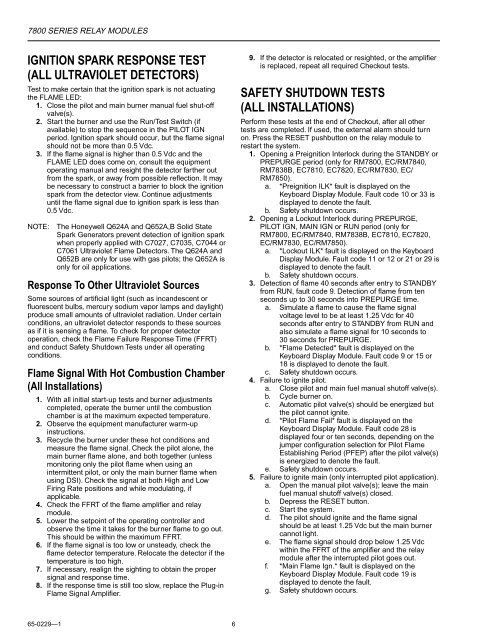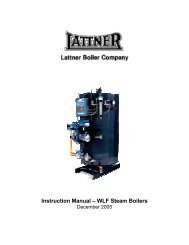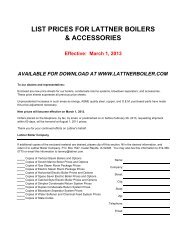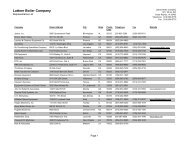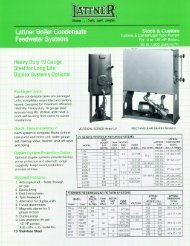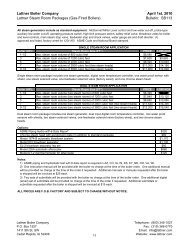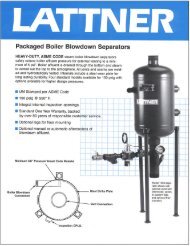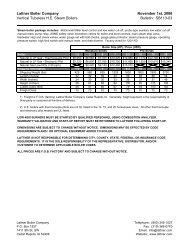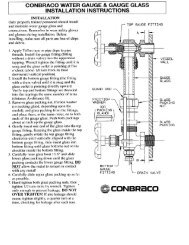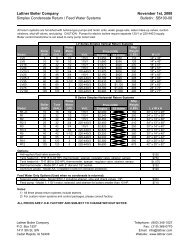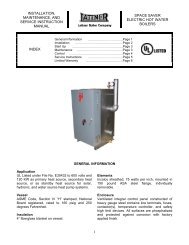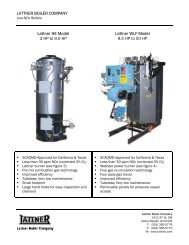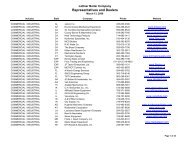65-0229 - 7800 SERIES Relay Modules - Greenheck
65-0229 - 7800 SERIES Relay Modules - Greenheck
65-0229 - 7800 SERIES Relay Modules - Greenheck
You also want an ePaper? Increase the reach of your titles
YUMPU automatically turns print PDFs into web optimized ePapers that Google loves.
<strong>7800</strong> <strong>SERIES</strong> RELAY MODULES<br />
IGNITION SPARK RESPONSE TEST<br />
(ALL ULTRAVIOLET DETECTORS)<br />
Test to make certain that the ignition spark is not actuating<br />
the FLAME LED:<br />
1. Close the pilot and main burner manual fuel shut-off<br />
valve(s).<br />
2. Start the burner and use the Run/Test Switch (if<br />
available) to stop the sequence in the PILOT IGN<br />
period. Ignition spark should occur, but the flame signal<br />
should not be more than 0.5 Vdc.<br />
3. If the flame signal is higher than 0.5 Vdc and the<br />
FLAME LED does come on, consult the equipment<br />
operating manual and resight the detector farther out<br />
from the spark, or away from possible reflection. It may<br />
be necessary to construct a barrier to block the ignition<br />
spark from the detector view. Continue adjustments<br />
until the flame signal due to ignition spark is less than<br />
0.5 Vdc.<br />
NOTE: The Honeywell Q624A and Q<strong>65</strong>2A,B Solid State<br />
Spark Generators prevent detection of ignition spark<br />
when properly applied with C7027, C7035, C7044 or<br />
C7061 Ultraviolet Flame Detectors. The Q624A and<br />
Q<strong>65</strong>2B are only for use with gas pilots; the Q<strong>65</strong>2A is<br />
only for oil applications.<br />
Response To Other Ultraviolet Sources<br />
Some sources of artificial light (such as incandescent or<br />
fluorescent bulbs, mercury sodium vapor lamps and daylight)<br />
produce small amounts of ultraviolet radiation. Under certain<br />
conditions, an ultraviolet detector responds to these sources<br />
as if it is sensing a flame. To check for proper detector<br />
operation, check the Flame Failure Response Time (FFRT)<br />
and conduct Safety Shutdown Tests under all operating<br />
conditions.<br />
Flame Signal With Hot Combustion Chamber<br />
(All Installations)<br />
1. With all initial start-up tests and burner adjustments<br />
completed, operate the burner until the combustion<br />
chamber is at the maximum expected temperature.<br />
2. Observe the equipment manufacturer warm-up<br />
instructions.<br />
3. Recycle the burner under these hot conditions and<br />
measure the flame signal. Check the pilot alone, the<br />
main burner flame alone, and both together (unless<br />
monitoring only the pilot flame when using an<br />
intermittent pilot, or only the main burner flame when<br />
using DSI). Check the signal at both High and Low<br />
Firing Rate positions and while modulating, if<br />
applicable.<br />
4. Check the FFRT of the flame amplifier and relay<br />
module.<br />
5. Lower the setpoint of the operating controller and<br />
observe the time it takes for the burner flame to go out.<br />
This should be within the maximum FFRT.<br />
6. If the flame signal is too low or unsteady, check the<br />
flame detector temperature. Relocate the detector if the<br />
temperature is too high.<br />
7. If necessary, realign the sighting to obtain the proper<br />
signal and response time.<br />
8. If the response time is still too slow, replace the Plug-in<br />
Flame Signal Amplifier.<br />
<strong>65</strong>-<strong>0229</strong>—1<br />
6<br />
9. If the detector is relocated or resighted, or the amplifier<br />
is replaced, repeat all required Checkout tests.<br />
SAFETY SHUTDOWN TESTS<br />
(ALL INSTALLATIONS)<br />
Perform these tests at the end of Checkout, after all other<br />
tests are completed. If used, the external alarm should turn<br />
on. Press the RESET pushbutton on the relay module to<br />
restart the system.<br />
1. Opening a Preignition Interlock during the STANDBY or<br />
PREPURGE period (only for RM<strong>7800</strong>, EC/RM7840,<br />
RM7838B, EC7810, EC7820, EC/RM7830, EC/<br />
RM7850).<br />
a. *Preignition ILK* fault is displayed on the<br />
Keyboard Display Module. Fault code 10 or 33 is<br />
displayed to denote the fault.<br />
b. Safety shutdown occurs.<br />
2. Opening a Lockout Interlock during PREPURGE,<br />
PILOT IGN, MAIN IGN or RUN period (only for<br />
RM<strong>7800</strong>, EC/RM7840, RM7838B, EC7810, EC7820,<br />
EC/RM7830, EC/RM7850).<br />
a. *Lockout ILK* fault is displayed on the Keyboard<br />
Display Module. Fault code 11 or 12 or 21 or 29 is<br />
displayed to denote the fault.<br />
b. Safety shutdown occurs.<br />
3. Detection of flame 40 seconds after entry to STANDBY<br />
from RUN, fault code 9. Detection of flame from ten<br />
seconds up to 30 seconds into PREPURGE time.<br />
a. Simulate a flame to cause the flame signal<br />
voltage level to be at least 1.25 Vdc for 40<br />
seconds after entry to STANDBY from RUN and<br />
also simulate a flame signal for 10 seconds to<br />
30 seconds for PREPURGE.<br />
b. *Flame Detected* fault is displayed on the<br />
Keyboard Display Module. Fault code 9 or 15 or<br />
18 is displayed to denote the fault.<br />
c. Safety shutdown occurs.<br />
4. Failure to ignite pilot.<br />
a. Close pilot and main fuel manual shutoff valve(s).<br />
b. Cycle burner on.<br />
c. Automatic pilot valve(s) should be energized but<br />
the pilot cannot ignite.<br />
d. *Pilot Flame Fail* fault is displayed on the<br />
Keyboard Display Module. Fault code 28 is<br />
displayed four or ten seconds, depending on the<br />
jumper configuration selection for Pilot Flame<br />
Establishing Period (PFEP) after the pilot valve(s)<br />
is energized to denote the fault.<br />
e. Safety shutdown occurs.<br />
5. Failure to ignite main (only interrupted pilot application).<br />
a. Open the manual pilot valve(s); leave the main<br />
fuel manual shutoff valve(s) closed.<br />
b. Depress the RESET button.<br />
c. Start the system.<br />
d. The pilot should ignite and the flame signal<br />
should be at least 1.25 Vdc but the main burner<br />
cannot light.<br />
e. The flame signal should drop below 1.25 Vdc<br />
within the FFRT of the amplifier and the relay<br />
module after the interrupted pilot goes out.<br />
f. *Main Flame Ign.* fault is displayed on the<br />
Keyboard Display Module. Fault code 19 is<br />
displayed to denote the fault.<br />
g. Safety shutdown occurs.


